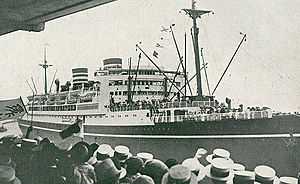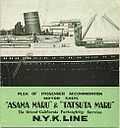Asama Maru
 Asama Maru 1931 | |
| Career (Japan) | |
|---|---|
| Name: | Asama Maru |
| Operator: | Nippon Yusen (NYK) |
| Builder: | Mitsubishi Shipbuilding & Engineering Co. Nagasaki, Japan |
| Yard number: | 450 |
| Laid down: | 10 September 1927 |
| Launched: | 30 October 1928 |
| Completed: | 15 September 1929 |
| In service: | 1929 |
| Out of service: | 1 November 1944 |
| Fate: | lost in war |
| Status: | torpedoed and sunk by USS Atule in the South China Sea, 100 mi (160 km) south of Pratas island |
| General characteristics | |
| Tonnage: | 16,975 gross register tons (GRT) |
| Length: | 583 ft (178 m) |
| Beam: | 71 ft (22 m) |
| Propulsion: | 4 Sulzer diesels, quadruple screws |
| Speed: | 21 knots (39 km/h) |
| Capacity: | 222 first class 96 second class 504 third class 822 total |
| Crew: | 330 |
| Notes: | Steel construction |
The Asama Maru (浅間丸 Asama maru) was a Japanese ocean liner owned by Nippon Yusen Kaisha. The ship was built in 1927-1929 by Mitsubishi Shipbuilding & Engineering Co. at Nagasaki, Japan.
The Asama Maru was built for the trans-Pacific Orient-California fortnightly service;[1] and she was characterized as "The Queen of the Sea."[2] Principal ports-of-call included Hong Kong, Shanghai, Kobe, Yokohama, Honolulu, Los Angeles & San Francisco.[3] On her fourth voyage from Yokohama to SanFrancisco, the speed of the ship's crossing surpassed the previous record.[4]
The vessel was created as a twin of the Tatsuta Maru; and both ships were named after important Shinto shrines.[5]
History
The first passenger liner built by NYK was Asama Maru.[6] The ship was built by Mitsubishi at Nagasaki on the southern island of Kyushu. The Asama Maru was launched on October 30, 1927. She left Yokohama on September 15, 1929 on her maiden voyage to California.[7]

The 16,975-ton vessel had a length of 583 feet (178 m), and her beam was 71 feet (22 m). The ship had 4 diesel motors, two funnels, two masts, quadruple screws and an average speed of 21-knots.[7] The Asama Maru was the first Japanese passenger liner to be propelled by diesel engines.[3]
The ocean liner provided accommodation for 222 first-class passengers and for 96 second class passengers. There was also room for up to 504 third-class passengers. The ship and passengers were served by a crew of 330.[3]
Pacific War
Before Japan's entry into the Second World War she was intercepted by the Royal Navy light cruiser HMS Liverpool 35 miles (56 km) from the coast of Niijima on January 21, 1940. Alerted to reports that Axis sailors in the United States were preparing to arrange transport to Germany, the British Government had authorised the C-in-C, China Station to direct a warship to detain certain passengers providing the coast of Japan was not within sight.[8] The Liverpool removed 21 of the ship's passengers believed to be survivors of the scuttled German liner Columbus.[9] The Government of Japan condemned it as an abuse of belligerent rights and formally protested the action, which further escalated tensions between the two countries.[9]
On 25 Oct. 1940, the Asam Maru departed San Francisco with 8 officers of the Columbus, and arrived Honolulu on 30 Oct. On 12 Nov., they reached Yokohama.[10]:50-53
In 1941 the ship became a troopship for the Imperial Japanese Navy.
In the summer of 1942, it was used in the repatriation of the prewar diplomatic staffs of Japan and the Allied nations, the exchange taking place at what is now Maputo.
In transporting Allied prisoners, it was amongst those vessels which earned the epithet "hell ships."
On November 1, 1944, Asama Maru was torpedoed and sunk by the US submarine USS Atule in the South China Sea 100 miles (160 km) south of the island of Pratas.
See also
Notes
- ↑ Levine, David. Graphic Design from the 1920s and 1930s in Travel Ephemera: "Plan of Passenger Accommodation Motor Ships 'Asama Maru' & ' Tatsuta Maru,'" 1929.
- ↑ NYK (HongKong): history.
- ↑ 3.0 3.1 3.2 Derby, Sulzer diesel motors: Asama Maru. August 29, 2008.
- ↑ Derby, Sulzer: poster, speed record.
- ↑ Ponsonby-Fane, Richard. (1935). The Nomeclature of the N.Y.K. Fleet, p. 50.
- ↑ Tate, E. Mowbray. (1986). Transpacific steam: the story of steam navigation from the Pacific Coast of North America to the Far East and the Antipodes, 1867-1941, p. 68
- ↑ 7.0 7.1 Haworth, R.B. Miramar Ship Index: ID #4035342.
- ↑ Best, Antony (1995), Britain, Japan and Pearl Harbor: Avoiding War in East Asia, 1936-41, p96
- ↑ 9.0 9.1 Marder, Arthur Jacob (1981), Old Friends, New Enemies: The Royal Navy and the Imperial Japanese Navy, p106
- ↑ Giese, O., 1994, Shooting the War, Annapolis: United States Naval Institute, ISBN 1557503079
References
- Ponsonby-Fane, Richard Arthur Brabazon. (1935). The Nomeclature of the N.Y.K. Fleet. Tokyo : Nippon Yusen Kaisha. OCLC 27933596
- Tate, E. Mowbray. (1986). Transpacific steam: the story of steam navigation from the Pacific Coast of North America to the Far East and the Antipodes, 1867-1941. New York: Cornwall Books. 10-ISBN 0-8453-4792-6; 13-ISBN 978-0-8453-4792-8; OCLC 12370774
External links
| Wikimedia Commons has media related to Asama Maru (ship, 1929). |
- Shiplover: color image
- DerbySulzer: sepia image of ship aground at Hong Kong, 1937